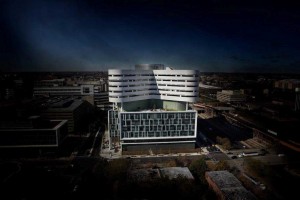
The spots build on an ongoing Rush campaign centering on clinicians in close conversations, but broaden the message to highlight features of the new hospital. “The hospital has a stunning physical design that is seen through spectacular helicopter shots of the exterior,” explained SPM’s executive creative director Rick Korzeniowski. “And though the advertising is still very conversational, we went to great lengths to make sure, in virtually every shot, you see glimpses of the building. That was a big departure from what we’ve done in the past.”
“The way we use our clinicians has made our ads very recognizable in the community,” added Rush associate vice president of marketing Lori Allen. “But this year’s campaign adds a new musical arrangement and striking images of the building that together send the message that something new and important is going on.”
The television spots are supported by a companion print and an out-of-home campaign that includes transit and unique bus shelters, whose photography was also shot by Cope.
Having Cope shoot for both broadcast and print had practical advantages in terms of time and costs. There were also important creative benefits. “The print and broadcast are very closely connected in this campaign, so it just made sense to have one person do both,” said Korzeniowski. “It makes the integration work. Having Gil involved in everything makes it all more coherent…and easier to do.”
SPM Marketing & Communications’ creative team, led by creative director Bob Konold, and Dark Light Pictures have been collaborating with Rush on its advertising campaigns for more than eight years. “It’s been a wonderful partnership,” said SPM managing partner Patti Winegar. “The new ads are the latest in a series of campaigns that have provided Rush with a distinctive brand identity and strong brand recognition in the Chicago market.”
Cope and his crew spent six days at the new hospital shooting live-action and print elements. That effort involved a number of logistical challenges, in part, because the hospital was still under construction. “We had to work around parts of the building that were unfinished,” noted Korzeniowski. “Rush staff were incredibly cooperative and bent over backwards to ensure that Gil and our team had everything they needed. That allowed us to show off the building in its best light.”
Cope also had to work around the schedules of the talent – many of whom were busy working physicians. “Gil’s experience in shooting in hospitals is invaluable,” said Korzeniowski. “When shooting in a working hospital environment, so many things have to fall into place – particularly when you are using real doctors and other staff. They may be coming from or going to surgery.
“We’ve got to be locked and loaded so that we can get them in and out on schedule. We can’t have them waiting around for hours. Those are issues you don’t normally face when you’re shooting on a stage or other location.”
Although Cope’s advertising work encompasses a wide variety of subjects, the director said that he has a special passion for hospitals. “We’re promoting a service that saves people’s lives,” he said. “It’s very rewarding to think that these ads may inspire people to come to this building to get the care that they need.”





